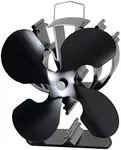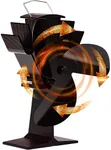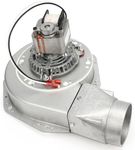Buying Guide for the Best Stove Fan For Woodstove
Choosing the right stove fan for your woodstove can significantly enhance the efficiency of your heating system. A stove fan helps to distribute the warm air generated by your woodstove more evenly throughout the room, making your space more comfortable and reducing the amount of wood you need to burn. To find the best stove fan for your needs, consider the following key specifications and how they align with your specific requirements.Power SourceStove fans can be powered by either electricity or the heat from the stove itself. Heat-powered fans, also known as thermoelectric fans, generate their own electricity from the heat of the stove, making them more energy-efficient and convenient as they don't require an external power source. Electric fans, on the other hand, need to be plugged in but can offer more consistent performance. If you prefer a fan that operates independently and saves on electricity, a heat-powered fan is a great choice. However, if you need a fan that can run continuously regardless of the stove's temperature, an electric fan might be more suitable.
Airflow CapacityAirflow capacity, measured in cubic feet per minute (CFM), indicates how much air the fan can move. This is crucial for determining how effectively the fan can distribute heat throughout your space. Lower CFM ratings (around 100-150 CFM) are suitable for smaller rooms or if you only need a gentle circulation of air. Medium CFM ratings (150-250 CFM) are ideal for average-sized rooms, providing a good balance of airflow and efficiency. Higher CFM ratings (250+ CFM) are best for larger spaces or if you need to move a significant amount of air quickly. Consider the size of your room and how much air circulation you need when choosing the airflow capacity.
Noise LevelThe noise level of a stove fan can impact your comfort, especially if the fan is used in a living area or bedroom. Noise levels are typically measured in decibels (dB). Fans with lower noise levels (below 25 dB) are very quiet and suitable for spaces where silence is important. Moderate noise levels (25-40 dB) are generally acceptable for most living areas, providing a balance between performance and quiet operation. Higher noise levels (above 40 dB) might be more noticeable and could be distracting in quieter environments. Consider where you will be using the fan and how sensitive you are to noise when selecting a fan.
Size and DesignThe size and design of the stove fan can affect both its performance and how well it fits with your woodstove and room decor. Smaller fans are more compact and can be easily placed on top of the stove without taking up much space, making them ideal for smaller stoves or limited space. Larger fans can move more air but require more space on the stove. The design also matters if you want the fan to complement your room's aesthetics. Choose a fan that fits well on your stove and matches your style preferences while ensuring it can effectively circulate air in your space.
Build Quality and DurabilityThe build quality and durability of a stove fan are important for ensuring long-term performance and reliability. Fans made from high-quality materials like metal are generally more durable and can withstand the high temperatures of a woodstove. Plastic fans might be less expensive but can be less durable and more prone to damage from heat. Look for fans with sturdy construction and good reviews regarding their longevity. If you use your woodstove frequently, investing in a well-built fan can save you from having to replace it frequently.




















